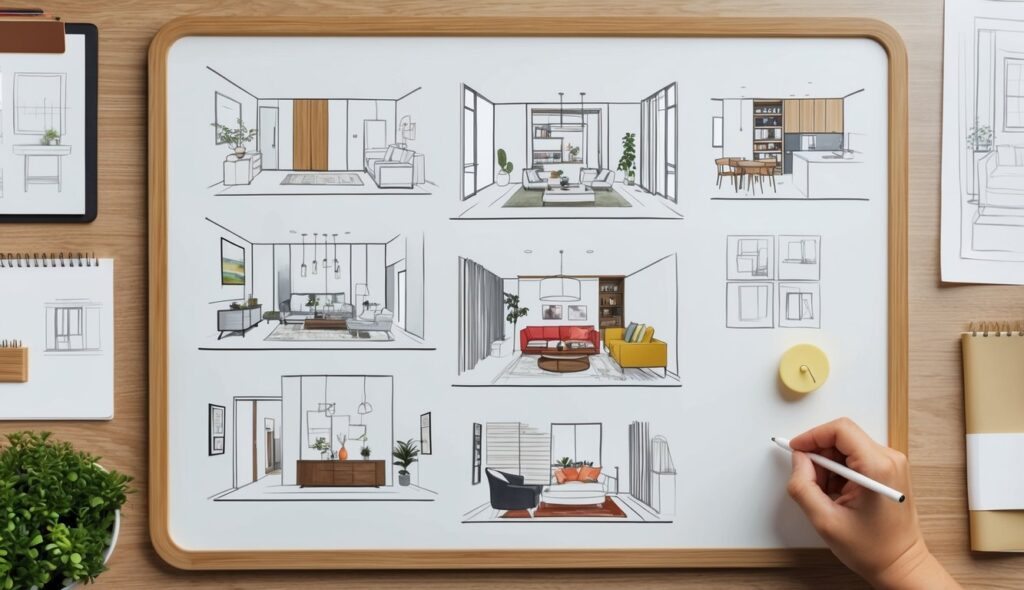The choice of paint in sustainable architecture plays a pivotal role in reducing the environmental impact of buildings.
Remember to repin your favorite images!
By selecting low-VOC (Volatile Organic Compounds) paint, architects can significantly minimize air pollution and promote healthier indoor air quality.
This choice aligns with green building standards, ensuring that projects meet stringent environmental regulations.
Paints have evolved beyond aesthetics to become a crucial component in sustainable design.
Innovative products like Ecolour’s water-based paint not only provide vibrant hues but also incorporate sustainable materials that contribute to energy efficiency and durability.
These advancements help in extending the lifespan of both exterior and interior surfaces, reducing the need for frequent repainting.
Integrating natural pigments into architectural projects is another forward-thinking approach.
These pigments, derived from earth minerals and plant sources, offer a wide range of applications while being environmentally friendly.
Projects highlighted in ArchDaily demonstrate how such materials can enhance the visual appeal and sustainability of buildings.
The strategic use of color and materials can transform spaces, reflecting both innovation and commitment to environmental stewardship.
The Impact of Paint on Environmental Sustainability
The impact of paint on environmental sustainability encompasses various factors. These factors include the composition of materials, regulation of VOCs, advancements in painting technologies, and the lifecycle of paint in architecture.
Composition and Sustainable Materials
Paint composition plays a vital role in sustainability.
Modern builders are increasingly using paints made from renewable resources and natural materials. Examples include water-based paint and eco-friendly paint containing fewer harmful additives and solvents.
Switching to sustainable materials in paint can help reduce the environmental footprint.
Recycled content and bio-based materials contribute to resource conservation.
Moreover, opting for natural pigments and binders further minimizes the ecological impact.
Volatile Organic Compounds (VOCs) and Regulations
Volatile Organic Compounds (VOCs) are harmful chemicals that evaporate as paint dries.
These compounds contribute significantly to indoor and outdoor air pollution.
Regulations around the globe are tightening the permissible levels of VOCs in paint products.
Architects and builders must select low-VOC or zero-VOC paints to comply with regulations and promote healthier living environments.
Compliance not only meets legal requirements but also aligns with green building standards such as LEED.
Innovative Painting Technologies for Energy Efficiency
Recent technological innovations in paint include products designed for energy efficiency.
Reflective paint, for instance, can mitigate urban heat island effects by reflecting sunlight, thereby cooling buildings and reducing the need for air conditioning.
Incorporating such innovative technologies can lead to higher energy efficiency and lower operational costs.
These advancements also support broader climate change mitigation efforts by reducing energy consumption and greenhouse gas emissions.
Lifecycle and Durability of Paint in Architecture
The durability of paint is crucial for sustainable architecture.
High-quality sustainable paint can last longer, minimizing the frequency of repainting and the associated environmental impact. Advanced formulations resist weathering, fading, and peeling.
Considering the lifecycle of paint, from production to application and disposal, is essential.
Paints with extended durability contribute to both environmental sustainability and cost-efficiency over the building’s life.
Such long-lasting solutions align with the principles of sustainable architecture by enhancing longevity and reducing materials waste.
Influence of Paint in Sustainable Architectural Design
Applying innovative paints in sustainable architecture enhances both aesthetics and performance. Various paints improve color dynamics, indoor air quality, and even the functionality of modern structures through new technologies.
The Role of Color in Sustainable Architecture
Color plays a significant role in influencing mood and well-being. Different hues can impact the perception of space and light, making rooms appear larger or more intimate.
In sustainable architecture, color choice is vital for energy efficiency. Light colors reflect more light, minimizing the need for artificial lighting.
The use of darker shades can help in climates that benefit from heat absorption. Design professionals must consider local climate and user needs when selecting paint colors for sustainable buildings.
Paint and Indoor Environmental Quality
Paint contributes to indoor air quality by minimizing emissions of volatile organic compounds (VOCs).
Low-VOC and zero-VOC paints are crucial in sustainable design because they reduce harmful solvents released into the air.
These choices improve ventilation and lower health risks.
Additionally, the use of antimicrobial coatings helps to inhibit mold and bacteria growth, which is essential for maintaining a healthy indoor environment.
Advancements in Functional and Smart Paints
Functional and smart paints are revolutionizing contemporary architecture.
Heat-reflective and insulating paints enhance energy efficiency by aiding temperature regulation.
Nano paints can add properties such as water resistance or self-cleaning surfaces.
New innovations in smart coatings include paints that can change color with temperature variations or provide electronic functionality.
For example, certain compositions can integrate sensors and actuators to monitor structural health or environmental conditions.
The development of cost-effective, high-performance paints continues to drive sustainable architectural design forward.
These advancements in paint and coatings are not only addressing the aesthetic preferences but are enhancing the overall sustainability and efficacy of modern buildings.

